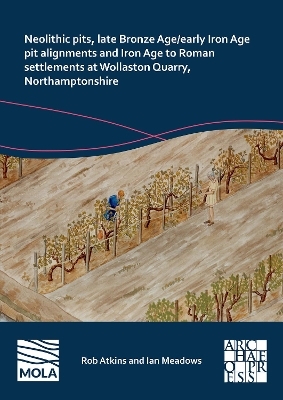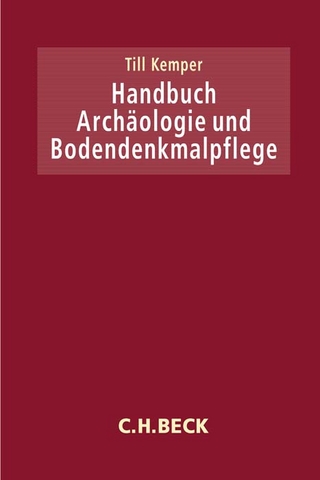
Neolithic Pits, Late Bronze Age/Early Iron Age Pit Alignments and Iron Age to Roman Settlements at Wollaston Quarry, Northamptonshire
Archaeopress Archaeology (Verlag)
978-1-80327-751-6 (ISBN)
Between 1990 and 1998, MOLA (Museum of London Archaeology) undertook a series of archaeological excavations within Wollaston Quarry covering an area of 116ha. Eight excavation areas and a watching brief were undertaken. The proximity of the River Nene and at least four palaeochannels formed the dominant natural landscape features. This dynamic environment affected settlement and land use throughout prehistoric and Roman periods.
Seventeen pits, largely in small groups, were identified containing early Neolithic to late Neolithic/early Bronze Age pottery. Some of these features were located within the area of the palaeochannels. Later, of especial interest was a notable collection of eleven different late Bronze Age to early Iron Age pit alignments, which were part of a co-axial landscape over an area of 2.5km². There was also a small area of domestic activity reflected by pits dating to the early Iron Age as well as two large watering holes in other locations. The pit alignment boundaries influenced subsequent settlement from the middle Iron Age to the late Roman periods. While individual settlements and related agricultural enclosures changed location over time, they followed the same alignments as the earlier pit alignments suggesting some form of continuity for over 800 years.
In the middle to late Iron Age four separate farmsteads were established of which two overlaid the former pit alignments. All four comprised sub-rectangular enclosed farmsteads with internal roundhouses and paddocks. Towards the end of the Iron Age at least one of the middle Iron Age settlements was abandoned, while at roughly the same time an unenclosed settlement was created nearby which continued to the late Roman period. Overall, within the quarry, six new late Iron Age and Roman settlements were established and two more have been preserved without excavation. In the middle Roman period, there was extensive and organised agriculture activity which included two vineyards in two different parts of the site as well as two areas of paddock type enclosures. This level of planning suggests significant investment and could reflect the development by a villa estate. In the early to middle Saxon period there were four different areas of activity which comprised a sunken featured building, pits and a late 7th century grave of a high-status Anglian warrior burial (the latter has previously been reported on separately).
Chapter 1. Introduction
Project background
Archaeological background
Topography and geology
Summary of sites and site chronology
Site phasing
Chapter 2. The archaeological evidence
Period 0: Lower Palaeolithic to early Mesolithic (40000-7000BC) (Figs 2.1-2.3)
Period 1: Late Mesolithic/Early Neolithic to middle Bronze Age (7000-1100BC) (Figs 2.1-2.3)
Period 2: Late Bronze Age to early Iron Age (1100-400BC) (Figs 2.1 and 2.4)
Periods 3-5: Middle Iron Age to late Roman (400BC-AD400): sites to the north of Hardwater Road
Period 6: Saxon
Chapter 3. Finds
Lower Palaeolithic hand axes by William Boismier
Wollaston polissoir by JT Rowland
Flint from the excavations by Ian Meadows
The later Neolithic pottery by Alex Gibson
Early Prehistoric (Period 1) pottery by Jane Timby
Early Iron Age to Saxon pottery by Jane Timby
Fired clay objects by Ian Meadows
Brooches by D F Mackreth
Roman coins, metal objects and glass by Ian Meadows
Roman shoes by June Swann
The querns and millstones by Andy Chapman
Chapter 4. Human, faunal and environmental evidence
Human bone by Simon Chapman
Macroscopic plant and invertebrate remains in Settlement 1 by Mark Robinson
Phosphate analysis of Settlement 2 layer (5421) by J L Heathcote
Pollen analysis of Settlement 8 late Roman water hole/ well [1060] by Z Ruiz, A G Brown, P G Langdon
Chapter 5. Discussion
Period 0: Lower Palaeolithic to early Mesolithic (c.200000-7000BC)
Period 1: Late Mesolithic/early Neolithic to middle Bronze Age (7000-1100BC)
Period 2: Late Bronze Age to early Iron Age (1100-400BC)
Periods 3 and 4: Middle to late Iron Age (400BC to AD43)
Periods 4-5: Latest Iron Age to late Roman (c.AD0-cAD400)
Period 6: Saxon
Bibliography
| Erscheinungsdatum | 06.04.2024 |
|---|---|
| Zusatzinfo | 60 figures, 15 tables |
| Verlagsort | Oxford |
| Sprache | englisch |
| Maße | 205 x 290 mm |
| Themenwelt | Geisteswissenschaften ► Archäologie |
| ISBN-10 | 1-80327-751-3 / 1803277513 |
| ISBN-13 | 978-1-80327-751-6 / 9781803277516 |
| Zustand | Neuware |
| Informationen gemäß Produktsicherheitsverordnung (GPSR) | |
| Haben Sie eine Frage zum Produkt? |
aus dem Bereich


